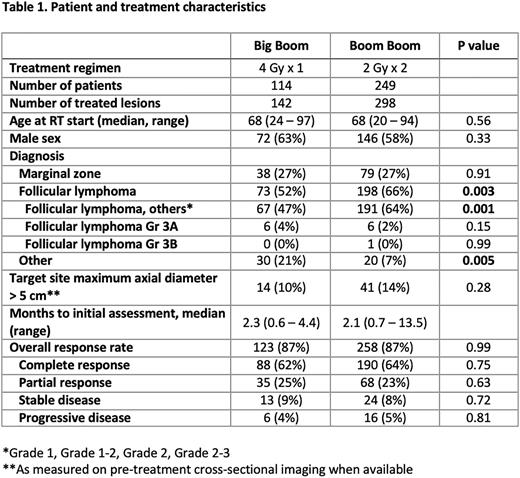Abstract
Purpose/Objectives Indolent lymphomas are exquisitely sensitive to radiation. Recently, programs of only 4 Gy in 2 daily fractions (Boom-Boom) were shown to be highly effective in controlling irradiated site(s). During the COVID-19 pandemic, the International Lymphoma Radiation Oncology Group (ILROG) proposed guidelines that allowed substitution of the Boom Boom (2 Gy x 2) regimen with Big Boom single fraction regimen of only 4 Gy. This report compares our center's experience with Big Boom to Boom-Boom.
Materials/Methods All consecutive indolent lymphomas were included. After April 2020 both options of very low dose as well as choice of a standard full dose of 24 Gy were discussed with the patient and choice was made with consideration of access logistics, patient preference as well as disease site(s). Patients were treated with a definitive or palliative intent depending on disease stage and prior therapy exposure. Patients treated with 24 Gy are not included in this report. Overall response rate was assessed with Lugano PET criteria at the initial post-RT imaging. Differences between the two groups were examined using the Fisher's exact test and Mann-Whitney test.
Results We evaluated a total of 440 lesions in 363 patients, including 142 lesions (32%) treated with 4 Gy x 1 ("Big Boom") and 298 lesions (67%) treated with 2 Gy x 2 ("Boom Boom"). Table 1 summarizes the patient and treatment characteristics. Patient age at the time of RT, sex, and the proportion of treated lesions with maximum axial diameter of greater than 5 cm were not significantly different between the two groups. Marginal zone lymphoma comprised 27% of each cohort. The Big Boom cohort was more likely to have follicular lymphomas (66% vs 52%, p = 0 .003), though the proportion of higher-grade follicular lymphomas was similar between cohorts. The overall response rate was 87% for both groups at the first post-RT evaluation (median of 2 months from RT for both cohorts). Furthermore, there was no significance difference in the rate of complete response, partial response, stable disease, or progressive disease between the cohorts at initial post-RT imaging. For both regimens, no directly related short-term side effects were observed.
Conclusions Both the Big Boom and Boom Boom regimens demonstrated excellent overall response rates at the initial post-RT imaging assessment among patients with indolent lymphomas. While longer term follow-up is required to confirm durability of these findings, our initial experience suggests that the single dose, single visit Big Boom regimen (4 Gy x 1) recommended by ILROG during the Covid-19 pandemic is an effective treatment approach.
Disclosures
Lebow:Oncia Technologies, Inc: Current equity holder in publicly-traded company. Imber:GT Medical Technologies: Honoraria.
Author notes
Asterisk with author names denotes non-ASH members.


This feature is available to Subscribers Only
Sign In or Create an Account Close Modal